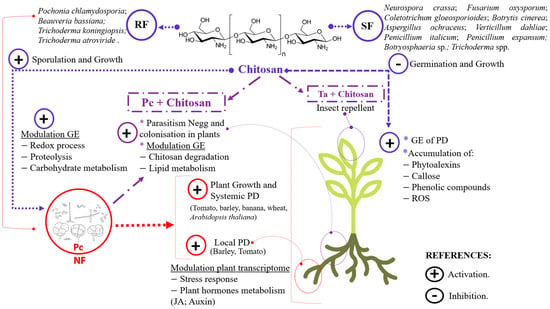Nematophagous fungi (NFs), which are responsible for soil suppression of plant-parasitic nematodes, are multitrophic biocontrol agents. This raises the question of the transition between lifestyles (e.g., endophytism vs. egg parasitism). The NF Pochonia chlamydosporia colonises food crops and promotes their growth and yield. When colonising the plant, P. chlamydosporia induces the plant immunity (PI). However, it also evades the PI. To do this, both endophytic NF and pathogenic fungi (PF) secrete LysM effectors (LysM-effs). LysM effectors have been shown to have diverse functions in different organisms, including the protection of fungal chitin from plant chitinases. P. chlamydosporia is resistant to chitosan, which modulates gene expression in fungi and plants and has antimicrobial properties. P. chlamydosporia chitin deacetylases (CDA) and chitosanases (CSN) also help P. chlamydosporia evade plant immunity, resist exogenous chitosan, and are induced during fungal infection of nematode eggs. NF-chitosan formulations are new biomanagement tools against plant parasitic nematodes, fungal wilt pathogens and insect pests that currently threaten food security crops. Furthermore, omics techniques are useful tools to elucidate the role of CDAs, CSNs, LysM-effs, adhesion proteins and carbohydrate-active enzymes in pathogen–BCA–plant interactions, adhesion and infection to nematode eggs and their modulation by chitosan.
A plethora of nematophagous, mycoparasitic, plant- and insect-pathogenic, plant-endophytic, and saprophytic fungi belong to the order Hypocreales. Some of these fungi can switch between different lifestyles [
1,
2]. Nematophagous fungi (NFs), such as
Pochonia chlamydosporia and
Purpureocillium lilacinum, have been identified in nematode-suppressive soils [
3,
4].
P. chlamydosporia is a cosmopolitan biocontrol fungus which can parasitize females and eggs of cyst- and root-knot nematodes but also colonises endophytically the roots of many crops [
5]. The multitrophic nature of these fungal biocontrol agents (BCAs) is paramount for their efficacy because, unlike conventional agrochemicals, they can be host-specific and persist in the environment. This leads to long-term host management [
6] with low environmental impact and no damage to human health, unlike toxic agrochemicals.
Deacetylation of chitin results in the formation of chitosan (
Figure 1). This occurs when the degree of deacetylation of chitin reaches approximately 50% due to solubilisation and protonation of the -NH
2 functional group at the C-2 position of the D-glucosamine repeat unit [
7]. Chitosan is thus a linear polymer of beta-(1-4)-linked N-acetyl-2-amino-2-deoxy-d-glucose and 2-amino-2-deoxy-d-glucose subunits [
8]. It is also the only cationic biopolymer, with a wide range of applications, such as flocculant for protein recovery or decontamination [
7]. The N-deacetylation of chitin and chitooligosaccharides is catalysed by chitin deacetylases (CDAs). These enzymes have different substrate specificities and give rise to fully or partially deacetylated products with various deacetylation patterns [
9]. The main raw materials to obtain chitosan are marine crustacean exoskeletons [
10]. Therefore, the multiple applications of this compound add value to the waste of the shellfish industry. As an alternative to toxic agrochemicals, chitosan may reduce current soil, marine, and freshwater pollution rates. Chitosan has antimicrobial properties and modulates the gene expression of plants and fungi [
8]. It can be combined with fungal BCAs to protect global food security crops [
11].
Figure 1. Effects of chitosan on biocontrol fungi and plants. Responses of nematophagous fungi (NFs, red) to chitosan (completely deacetylated as portrayed) and plants to NF combined with Chitosan (purple) are displayed. Abbreviations: RF—chitosan-resistant fungi; SF—chitosan-sensitive fungi; NFs—nematophagous fungi; Pc—
Pochonia chlamydosporia [
12]; Negg—nematode eggs; GE—gene expression; PD—plant defences; JA—jasmonic acid; ROS—reactive oxygen species; Ta—
Trichoderma atroviride.
Polysaccharide deacetylases are widely distributed in fungi and other organisms [
13,
14,
15]. They have been reported to have diverse functions in developmental processes other than virulence [
9,
16,
17,
18,
19,
20,
21,
22]. For instance, the fungal pathogen
Magnaporthe oryzae expresses CDAs during appressorium development. Additionally, chitosan is a cell wall component of germ tubes and appressoria of
M. oryzae [
17]. Alternatively, chitosan could promote the avoidance of plant immunity (PI) and fitness/virulence of fungal pathogens, including BCAs such as
P. chlamydosporia [
8]. Moreover, fungal effectors (F-effs) prevent pathogen recognition by plants, suppressing host immune responses (IR), and manipulating host cell physiology to facilitate colonisation [
23]. Many effectors and their modes of action have been well identified and characterized as LysM domains effectors (LysM-effs) in fungi [
23]. Analysing fungi with different lifestyles, our research group has shown that LysM-effs, CDAs, chitosanases (CSNs), and other hydrolases contribute to fungal lifestyle [
24,
25,
26,
27,
28,
29].
This article describes recent advances in NF gene expression in relation to their multi-trophic lifestyles and their relevance as BCAs. The importance of their combination with natural elicitors, such as chitosan, and their modulatory and regulatory potential on fungi and plants is highlighted. The mechanisms of action and effects of NFs, PFs, and chitosan on plants are discussed in a cross-sectional and integrative manner, considering the relevance of F-effs, CDAs, CSNs, and plant cell wall-degrading enzymes in the evolution of NFs to evade PI.
This entry is adapted from the peer-reviewed paper 10.3390/encyclopedia4010026

